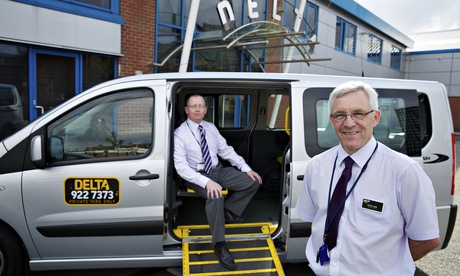
“If I get into a taxi, I can tell if the driver has been on one of the courses,” says Dennis Callaghan, 96, from Walton in Liverpool. “They immediately want to help, from the minute they see my two white sticks. They ask me if I need assistance, and when we get to the destination, they’ll usually get out to help me. It’s the difference in tone. They’re definitely more confident about taking a blind passenger.”
For blind and partially sighted people, especially the considerable number who find public transport unfeasible, a decent taxi service is often crucial for their freedom and control over their daily lives. It may seem obvious, but for visually impaired people, getting a taxi is actually quite complicated and often nerve-wracking, explains Diane Lister, 57, who is registered blind.
“When the driver rings to say they’ve arrived, you won’t know where on the road they are. They’ll wait for you, wondering where you are, while you try and make yourself visible and hope they’ll come up to you. Then when you are getting into the car, they tend to think you’ll be fine opening the door, but you won’t know if you need to bend down. They usually want to get away quickly, which can make you feel hurried and anxious. What you need is a person who understands you, who will knock, tell you who they are, take you by the elbow or arm and escort you to the car – telling you about any steps or stairs in the way.”
Guide dogs can add additional stress. “Mine is a golden retriever and might get her tail or her paw stuck in the door.”
But a new training scheme for taxi drivers aims to improve blind passengers’ experiences. “One thing I tell people is that a bad experience with a taxi driver can mean someone ends up not going out at all, because their confidence has been so knocked back,” says Mike Bailey, service director at Christopher Grange Visual Rehabilitation Centre in Liverpool. In 2012, Bailey and his colleagues started devising a training scheme for taxi drivers and offered it to local firm Delta. As with the schemes Christopher Grange provides to students and police officers, this is a bespoke course in specific things that taxi drivers need to think about and do when collecting and dropping off visually impaired passengers.
The training consists of a packed two hours, offered to 12 drivers at a time (costing £20 each). It starts with a tour of the centre and a quick overview of blindness and some of the most common eye conditions. Then the drivers are blindfolded and introduced to a “mystery guest” (one of the blind people who use the rehabilitation centre) and asked to guess a bit about them. After that – still blindfolded – they are asked to make themselves drinks and one by one are taken out to get their cab. “When you can’t see where you are you get a glimpse of what it is like to have to cope. They asked us to go from our classroom to a car, down a corridor and through the double doors, first with another person and then on our own,” says Alec Eve, 46, from Liverpool. “It’s very different, getting into a car when you can’t see the doors or even know how low down you’re supposed to bend to get on to the seat.”
“A lot of what we learned is common sense, but it’s things that wouldn’t occur to you on your own,” says Eve. “I’ve learned that grabbing someone’s arm is actually quite unhelpful; and that rather than automatically assuming a blind passenger wants assistance, we should ask them what they need. We’ve also been taught about guide dogs, and how they’re trained to a very high standard – they’re not going to make a mess of the vehicle and they certainly won’t bite you. And that not everyone is completely without any sight – that’s why my vehicle (pictured) has a lot of high-visibility elements, so that someone who has some vision can see the bits that are painted bright yellow.”
His colleague Steve Crawley, 45, was one of the first drivers to take the training, and is now a huge fan. “I learned a lot about what people go through in everyday life. I consider myself quite a courteous person, but I realised that I’d made big mistakes in grabbing people on the arm or the hip. These days I’m totally prepared for any visually impaired person to get into my vehicle, down to a special blanket for guide dogs. It’s the little things, like making sure you park on the right side of the road and not somewhere that will put them in danger. I make sure I know the person’s name so that I get out and ask for them by name and I make sure passengers don’t sit directly behind me, but across in the safest place for them to get out later.”
The course has gone from strength to strength. Last year it won an award from Visionary, the membership organisation for local independent charities that support blind and partially sighted people across the UK. The centre is offering training to other taxi firms too – with backing from the local council – and the course has been accredited by the organisation Open Awards.
“I’ve never met anyone who said they wasted their time coming: they’ll all say it was a pleasure,” says Tracy Finn, who is blind. “They’ll always give you a round of applause. They’re a great bunch of guys and if they ask a personal question, we’ll say no problem, they’re here to learn. We just want to be treated normal, like everyone else. We’re just trying to get back to everyday life.”

